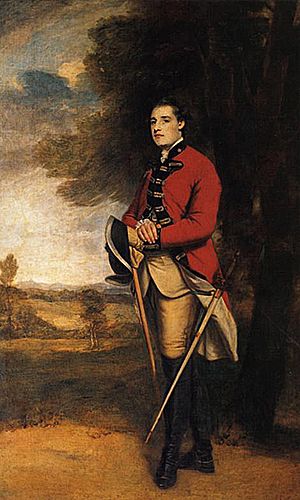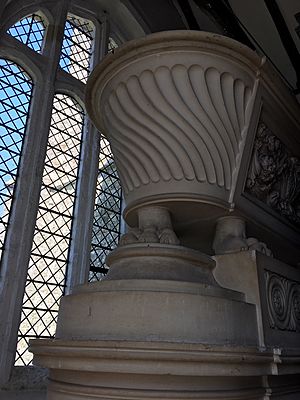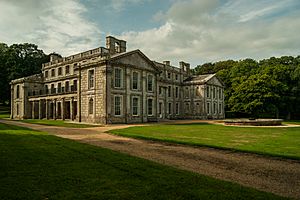Sir Richard Worsley, 7th Baronet facts for kids
Quick facts for kids
Sir Richard Worsley
|
|
|---|---|

by Joshua Reynolds (1775/6)
|
|
| Comptroller of the Household | |
| In office 1779–1782 |
|
| Preceded by | The Earl of Onslow |
| Succeeded by | The Earl Ludlow |
| Personal details | |
| Born | 13 February 1751 |
| Died | 8 August 1805 (aged 54) |
| Spouse | Seymour Dorothy Fleming |
Sir Richard Worsley, 7th Baronet (born February 13, 1751 – died August 8, 1805), was an important British politician. He lived at Appuldurcombe House on the Isle of Wight. Sir Richard was a Member of Parliament (MP) for many years. He was also famous for collecting ancient artifacts and artworks.
Contents
Early Life and Education
Richard Worsley was born on February 13, 1751. His family home was Appuldurcombe on the Isle of Wight. His father was Sir Thomas Worsley, 6th Baronet. His mother was Elizabeth Boyle. Richard became a Baronet himself when his father passed away in 1768.
He went to Winchester College for his schooling. From 1765 to 1767, he lived in Naples with his parents. In 1768, he started studying at Corpus Christi College, Oxford. Instead of finishing his degree, he went on a "Grand Tour" of Europe. This was a common trip for young wealthy men to complete their education. He traveled from 1769 to 1770.
Political Career
After his travels, Sir Richard Worsley returned to Britain. He served as the High Sheriff of Hampshire in 1773-74. This was an important local role. In 1774, he became a Member of Parliament (MP). He represented the area of Newport.
He supported the government led by Lord North. Because of this, he was given several important jobs. In 1777, he became a clerk comptroller. In 1779, he was made the Comptroller of the King's Household. This meant he managed the royal household's expenses. He also became a Privy Councillor in 1780. This was a special advisor to the King. From 1780 to 1782, he was the Governor of the Isle of Wight.
Changes in Political Roles
In 1782, the government he supported lost power. Because of this, Sir Richard lost all his official jobs. He then left England and traveled to Spain, Portugal, and France. He stayed in Rome for a winter. He returned to England in 1788.
Return to Parliament
Sir Richard Worsley became an MP again in 1790. This time, he represented Newtown on the Isle of Wight. He held this seat until 1793. From 1794 to 1797, he served as the British ambassador to the Republic of Venice. While there, he continued his passion for collecting ancient items. He also worked hard to protect Venice's neutrality during a time of war.
When the French invaded Venice in 1797, he managed to escape. He returned to England in September 1797. For his service, he received an annual payment from the Crown. He remained an MP for Newtown until 1801. After that, he retired from public life.
Collecting Ancient Treasures
Sir Richard Worsley was very interested in history and old objects. In 1778, he became a member of two important societies. These were the Society of Antiquaries of London and the Royal Society.
In 1785, he traveled to the Levant region. This area includes places like Greece, Turkey, and Egypt. He visited famous ancient sites like Athens and Troy. During these travels, he collected many valuable items. These included gems, paintings, sculptures, and ancient carvings. He arranged his large collection at his home, Appuldurcombe House. He even had the famous landscape designer, Capability Brown, work on his gardens. His collection of ancient Greek sculptures was one of the largest in Britain. It was even bigger than the famous Elgin Marbles collection for a time.
In the early 1790s, he built a new home called Sea Cottage. It was near St Lawrence. He added small classical temples to the grounds. In 1801, he learned that some of his art treasures had been captured by a French ship. Luckily, he was able to get his ancient artifacts back.
Later Life and Passing

Sir Richard Worsley continued collecting until he passed away. He died on August 8, 1805, at Appuldurcombe House. He was 54 years old. He was buried at the church in Godshill. Many of his collections were later moved to Brocklesby Park.
Published Works
Sir Richard Worsley also wrote books about his interests:
- He helped finish a History of the Isle of Wight in 1781. His father and grandfather had started this project.
- He published Museum Worsleianum (1794–1805). This was a detailed catalog of his amazing collection of ancient art.
- He also wrote a private catalog of paintings at Appuldurcombe in 1804.
Family Life
On September 20, 1775, Sir Richard Worsley married Seymour Dorothy Fleming. They had one son, Robert Edwin, who was born in 1776 but passed away in 1795.
Later in their lives, Sir Richard and his wife decided to live separately. After their separation, his wife used her birth name, Fleming. Sir Richard spent the rest of his life with Mrs. Sarah Smith.
After Sir Richard's passing, his title of Baronet went to his cousin, Henry Worsley-Holmes. His estate, Appuldurcombe, went to his niece, Henrietta Anna Maria Charlotte. She later married Charles Anderson-Pelham in 1806.



